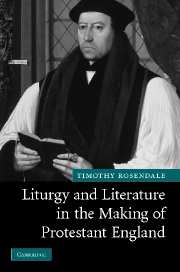3 - Representation and authority in Renaissance literature
Published online by Cambridge University Press: 22 September 2009
Summary
LITURGY AND LITERATURE
When the imprisoned Cranmer asked his interrogators in 1554, “who say it is necessary that he which useth to speak by tropes and figures should lie in so doing?”, he highlighted the centrality of representation and reading to the entire Reformation project. The hostility of his examiners to the destabilizing implications of figural reading – “whosoever saith that Christ spake by figures, saith that he did lie” – demonstrates how, despite its varied and extraordinarily rich medieval interpretive tradition, the Roman Catholic Church under Reformed pressure reverted to a dogmatic and uncompromising literalism, a hermeneutically reactionary rejection of figurality in general much like that often rather crudely attributed to Protestantism. The Reformed challenge, which undercut the institutional power of transubstantiation by circumventing it with a figural reading of the dominical words – and thus reorienting both doctrine and sacrament away from institution and elements and toward the individual – polarized this Reformation debate, like many others, around questions of rhetoric and interpretation, representation and hermeneutics. In this case, the old faith sought to control, minimize, annihilate the unruly space of signification; the new insisted that this space, both sacramental and scriptural, was the arena of truth.
This latter claim in particular is necessarily subject to some qualification: no mainline version of Protestantism endorsed or allowed an utterly free play of signs.
- Type
- Chapter
- Information
- Liturgy and Literature in the Making of Protestant England , pp. 133 - 177Publisher: Cambridge University PressPrint publication year: 2007



